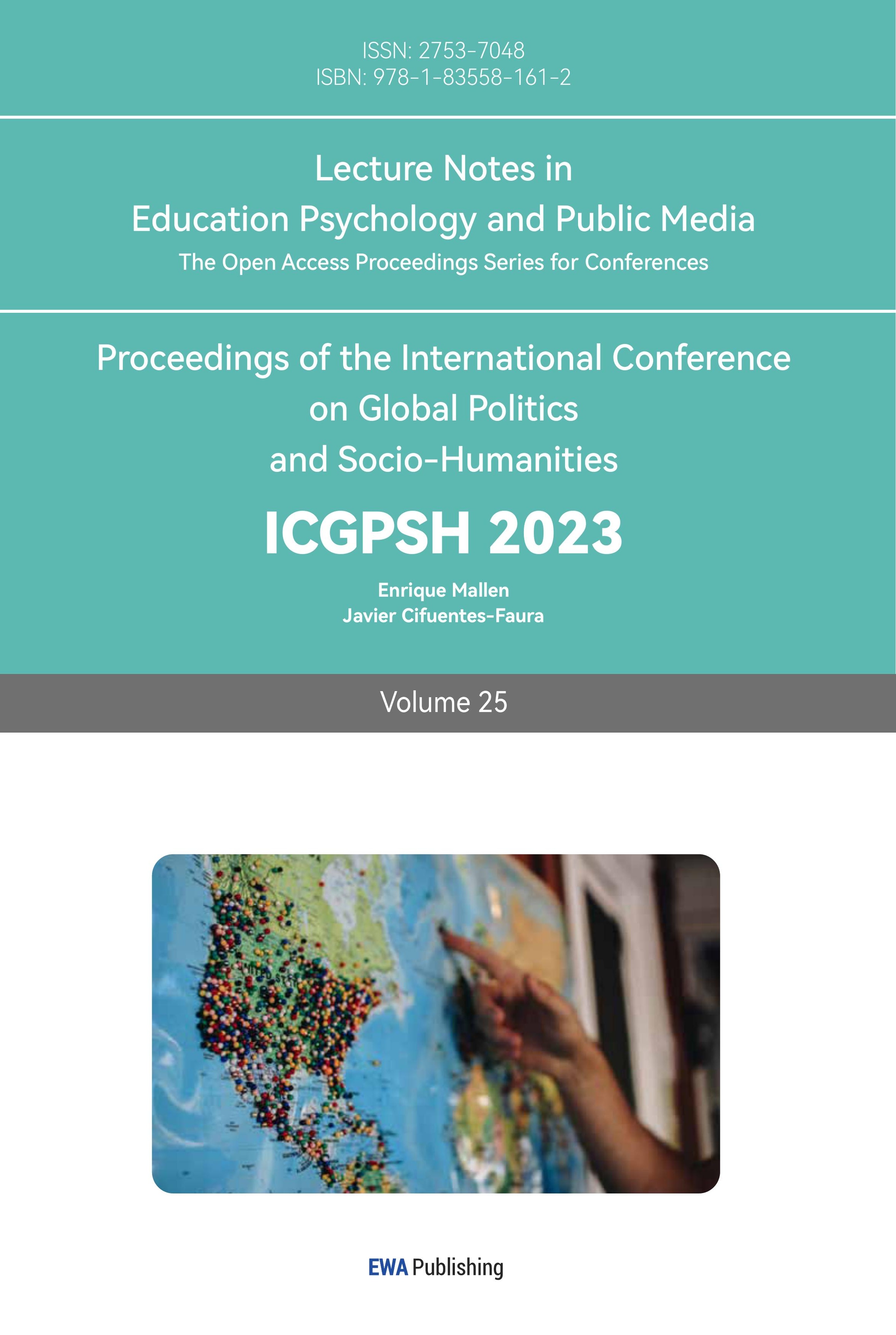References
[1]. John V. Pavlik. 2023. Collaborating With ChatGPT: Considering the Implications of Generative Artificial Intelligence for Journalism and Media Education [J]. Journalism & Mass Communication Educator. 278(1): 84-93.
[2]. Xu Xinxin. 2023. Scientific and Technological Ethical Issues and Legal Governance of ChatGPT [J]. Democracy and Law Times.
[3]. Michael singletary. 2000. Contemporary methods and application [M].
[4]. Joe Fedewa. 2023. What Is ChatGPT, and Why Is It Important[EB/OL]. How-To Geek, Feb8, 2023.
[5]. Yu Guoming, So Jianwei. 2018. Communication Revolution and media Ecology under the wave of Generative Artificial Intelligence [J]. Radio&TV Journal.
[6]. EduTaxTuber Team. 2023. What is ChatGPT[EB/OL]. https://tco/sHDm57g3Kr.
[7]. Peng LAN. 2023. The panorama and prospect of intelligent communication and human-machine relationship from ChatGPT [J]. Journalism Research, No.204(04):1-16+119.
[8]. Let’s dance the news! How the news media are adapting to the logic of TikTok. Journalism, 23(8), 1717-1735.
[9]. Ho, A., Hancock, J., & Miner, A. S. (2018). Psychological, relational, and emotional effects of self-disclosure after conversations with a chatbot. Journal of Communication, 68(4), 712-733.
[10]. Technology — Media Technology. 2020. Study Results from University of Pittsburgh Update Understanding of Media Technology (Producing newsgames beyond boundaries: Journalists, game developers, and the news business) [J]. Technology News Focus.
[11]. Sucameli, I. (2021). Improving the level of trust in human-machine conversation. Advanced Robotics, 35(9), 553-560.
[12]. Gondwe Gregory. 2023. CHATGPT and the Global South: how are journalists in sub-Saharan Africa engaging with generative AI? [J]. Online Media and Global Communication, 2(2):228-249.
[13]. Stokel-Walker Chris. 2023. ChatGPT’s knowledge of copyrighted novels highlights legal uncertainty of AI [J]. New Scientist, 258(3438):13-13.
Cite this article
Niu,J. (2023). An Analysis of Journalists’ Coping Strategies in the Face of ChatGPT. Lecture Notes in Education Psychology and Public Media,25,90-95.
Data availability
The datasets used and/or analyzed during the current study will be available from the authors upon reasonable request.
Disclaimer/Publisher's Note
The statements, opinions and data contained in all publications are solely those of the individual author(s) and contributor(s) and not of EWA Publishing and/or the editor(s). EWA Publishing and/or the editor(s) disclaim responsibility for any injury to people or property resulting from any ideas, methods, instructions or products referred to in the content.
About volume
Volume title: Proceedings of the International Conference on Global Politics and Socio-Humanities
© 2024 by the author(s). Licensee EWA Publishing, Oxford, UK. This article is an open access article distributed under the terms and
conditions of the Creative Commons Attribution (CC BY) license. Authors who
publish this series agree to the following terms:
1. Authors retain copyright and grant the series right of first publication with the work simultaneously licensed under a Creative Commons
Attribution License that allows others to share the work with an acknowledgment of the work's authorship and initial publication in this
series.
2. Authors are able to enter into separate, additional contractual arrangements for the non-exclusive distribution of the series's published
version of the work (e.g., post it to an institutional repository or publish it in a book), with an acknowledgment of its initial
publication in this series.
3. Authors are permitted and encouraged to post their work online (e.g., in institutional repositories or on their website) prior to and
during the submission process, as it can lead to productive exchanges, as well as earlier and greater citation of published work (See
Open access policy for details).
References
[1]. John V. Pavlik. 2023. Collaborating With ChatGPT: Considering the Implications of Generative Artificial Intelligence for Journalism and Media Education [J]. Journalism & Mass Communication Educator. 278(1): 84-93.
[2]. Xu Xinxin. 2023. Scientific and Technological Ethical Issues and Legal Governance of ChatGPT [J]. Democracy and Law Times.
[3]. Michael singletary. 2000. Contemporary methods and application [M].
[4]. Joe Fedewa. 2023. What Is ChatGPT, and Why Is It Important[EB/OL]. How-To Geek, Feb8, 2023.
[5]. Yu Guoming, So Jianwei. 2018. Communication Revolution and media Ecology under the wave of Generative Artificial Intelligence [J]. Radio&TV Journal.
[6]. EduTaxTuber Team. 2023. What is ChatGPT[EB/OL]. https://tco/sHDm57g3Kr.
[7]. Peng LAN. 2023. The panorama and prospect of intelligent communication and human-machine relationship from ChatGPT [J]. Journalism Research, No.204(04):1-16+119.
[8]. Let’s dance the news! How the news media are adapting to the logic of TikTok. Journalism, 23(8), 1717-1735.
[9]. Ho, A., Hancock, J., & Miner, A. S. (2018). Psychological, relational, and emotional effects of self-disclosure after conversations with a chatbot. Journal of Communication, 68(4), 712-733.
[10]. Technology — Media Technology. 2020. Study Results from University of Pittsburgh Update Understanding of Media Technology (Producing newsgames beyond boundaries: Journalists, game developers, and the news business) [J]. Technology News Focus.
[11]. Sucameli, I. (2021). Improving the level of trust in human-machine conversation. Advanced Robotics, 35(9), 553-560.
[12]. Gondwe Gregory. 2023. CHATGPT and the Global South: how are journalists in sub-Saharan Africa engaging with generative AI? [J]. Online Media and Global Communication, 2(2):228-249.
[13]. Stokel-Walker Chris. 2023. ChatGPT’s knowledge of copyrighted novels highlights legal uncertainty of AI [J]. New Scientist, 258(3438):13-13.









